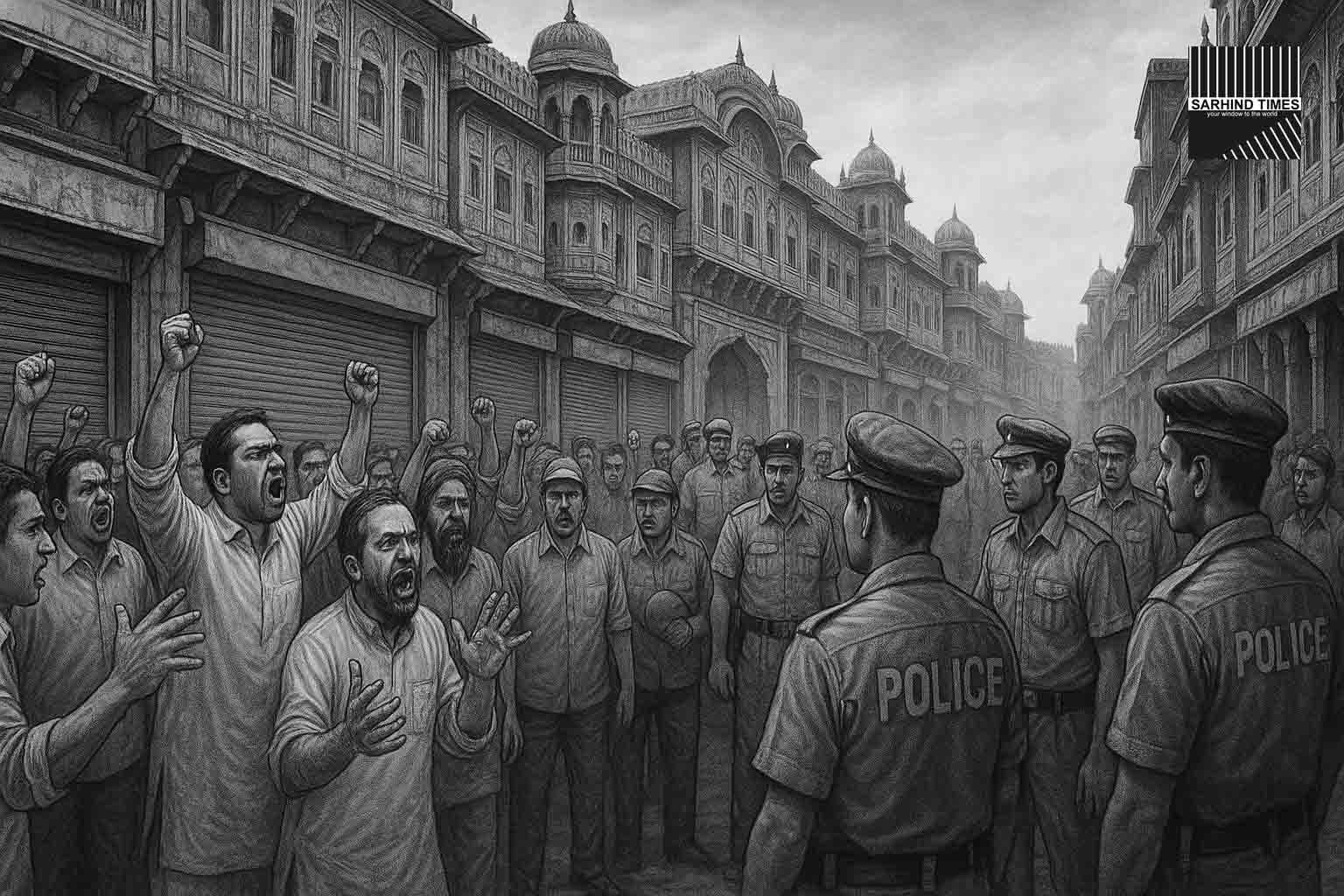New Delhi/Jaipur, September 28 (Sarhind Times Bureau):
The Supreme Court of India has granted interim relief to traders in Jaipur’s UNESCO-listed Walled City, halting the ongoing sealing of commercial establishments operating out of properties technically registered as residential. A bench of Justices Vikram Nath and Sandeep Mehta stayed a Rajasthan High Court order that had directed the Jaipur Municipal Corporation–Heritage (JMC-H) to seal such properties. The apex court’s decision provides a temporary breather to hundreds of shopkeepers and business owners who feared losing their livelihoods overnight.
The court has directed the state government and municipal authorities to file their detailed responses within four weeks, setting the stage for a landmark debate on the balance between heritage conservation and commercial livelihoods in one of India’s most historic urban centers.
Jaipur’s Walled City: The Heritage–Commerce Conundrum
Jaipur’s Walled City, with its pink facades, bazaars, and palaces, is globally renowned as a UNESCO World Heritage Site. But behind its picturesque arches lies a complex reality: thousands of commercial units operate from buildings legally classified as residential properties.
For decades, the old city’s bazaars—Johari Bazaar, Tripolia, Bapu Bazaar, and others—have thrived on a model where residential spaces gradually transitioned into shops and warehouses. The boom in jewelry, textiles, and handicrafts turned many family homes into business hubs.
Yet, urban planners argue this unchecked commercialization strains fragile heritage structures, compromises fire safety, and alters the very character of the historic city.
The Rajasthan High Court’s Intervention
In early September, the Rajasthan High Court ordered JMC-H to seal all properties in heritage zones that were:
- Registered as residential but operating commercially.
- Non-compliant with zoning and building-use laws.
The directive triggered panic among traders, as sealing squads moved swiftly into markets. Shop shutters were downed, protests erupted, and delegations rushed to state ministers seeking intervention.
Petitioners approached the Supreme Court, arguing that the HC acted prematurely, especially since a high-powered committee was still reviewing compliance and policy recommendations.
The Supreme Court’s Stay
The Supreme Court’s interim stay has:
- Paused sealing operations by JMC-H.
- Given traders temporary relief to continue operations.
- Directed state and municipal authorities to file responses in four weeks.
Legal experts suggest this stay reflects the court’s recognition of livelihoods at stake. However, it is not a permanent solution. The larger question remains: should heritage conservation override economic survival, or can both coexist?
Traders’ Relief, Lingering Anxiety
Local business communities welcomed the pause but expressed uncertainty.
- “We are relieved, but only temporarily. We need clarity on rules. Our families have run shops here for generations,” said Ramesh Mehta, a jeweler in Johari Bazaar.
- Another trader added: “If the government wants heritage, it must also provide alternative commercial spaces. Otherwise, sealing will kill the old city’s economy.”
Many pointed out that Jaipur’s heritage status itself depends on its living bazaars, not empty facades.
Experts Call for Balance
Urban planners and conservationists argue for a middle path.
- Dr. Anjali Sharma, an urban heritage expert, said:
“We cannot allow commercialization to hollow out the Walled City. But sealing entire markets without rehabilitation plans is destructive. What we need is regulated commerce, structural retrofitting, and fire-safety compliance.”
- Policy analysts suggest mixed-use zoning laws to formally recognize businesses while imposing safety and conservation conditions.
Fire Safety and Urban Risks
The debate is not merely legal. Jaipur’s Walled City has witnessed repeated fire incidents in congested markets where narrow lanes prevent fire trucks from entering. Unregulated warehouses storing textiles, plastics, and chemicals in heritage havelis have added to the risks.
Officials warn that unless stricter safety norms are enforced, the city risks a catastrophic blaze that could devastate both commerce and culture.
Politics and Public Sentiment
The sealing drive quickly became political. Opposition parties accused the state government of “destroying livelihoods” ahead of elections, while ruling leaders insisted they were bound by court directives. Public sentiment in Jaipur leaned heavily in favor of traders, with protests drawing large crowds.
Civil society, however, remains divided: conservation groups fear unchecked commercialization, while residents argue for economic survival.
International Spotlight
As a UNESCO World Heritage Site, Jaipur is under international scrutiny. UNESCO guidelines stress preserving both the tangible architecture and intangible cultural heritage of heritage cities. Experts say Jaipur must evolve a model similar to historic centers in Europe, where commerce and conservation co-exist through strict but fair regulation.
Possible Paths Forward
Urban policy experts outline three possible directions:
- Strict Heritage Enforcement
- Continue sealing non-compliant units.
- Preserve architecture at all costs.
- High risk of economic backlash.
- Regulated Mixed-Use Model
- Legalize commercial activity under regulated norms.
- Mandate fire-safety retrofits and structural conservation.
- Balance heritage and livelihoods.
- Relocation Model
- Gradually move warehouses and high-risk businesses out of the Walled City.
- Create new commercial hubs with incentives.
- Retain cultural retail (jewelry, handicrafts) inside heritage zones.
The Supreme Court’s eventual ruling may shape which path Jaipur takes.
Wider Implications
This case is likely to set a precedent for heritage cities across India, including Varanasi, Amritsar, and Hyderabad, where similar tensions between commerce and conservation exist. If Jaipur can strike a balance, it may offer a model for urban India’s heritage future.
Conclusion
The Supreme Court’s stay has bought Jaipur’s traders some time, but the larger debate looms large. At stake is not just the fate of shopkeepers or the authority of conservationists, but the very soul of Jaipur’s Walled City—a place where commerce and culture have thrived side by side for centuries.
The coming months will reveal whether India’s judiciary and policymakers can craft a solution that honors both heritage and human survival.
#SupremeCourt #Jaipur #UrbanPolicy #Heritage #Law #Rajasthan #SarhindTimes #WalledCity






















+ There are no comments
Add yours